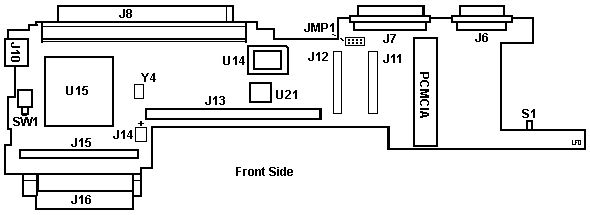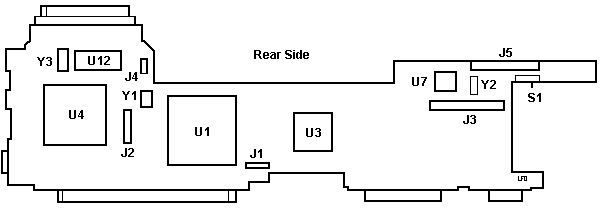|
r720m120.exe ThinkPad 720 Reference Disk (v1.20) (zipped image)
r720c120.exe ThinkPad 720C Reference Disk (v1.20) (zipped image)
dg720120.exe ThinkPad 700, 700C, 720, 720C Diagnostic Disk (v1.2) (zipped image)
700c120.exe ThinkPad 700C, 720C Video Driver 256 Color (v1.20) for Win3.1
700propm.exe ThinkPad 700C, 720C Video Display Control for OS/2
pctpx130.exe PCMCIA Disk (v1.3): ThinkPads 720/C (readme)
Video Card
Keyboard Control Board
Voltage Convertor
720 Planar, Front
720 Planar, Rear
PCMCIA
ThinkPad 720 Planar Front

J6 Serial Connector
J7 Parallel Connector
J8 System-Expansion Connector (240-pin)
J10 PS/2 port (Mouse/KB)
J11 PCMCIA card interface
J12 Base Memory Card Interface
J13 Video Card Interface
J14 Backup Battery Connector
J16 Hard Disk Drive Connector
|
J15 Processor Card Interface
JMP1 Unknown header
PCMCIA PCMCIA Connector
S1 Password-override switch
U14 BIOS 59G3639
U15 48G8905
U21 NS PC8477BVF-1 Floppy controller
Y4 14.138 MHz osc
|
There are upgrade BIOS chips available.
ThinkPad 720 Planar Rear

J1 System Status Indicator Connector
J2 Keyboard Control Card Interface
J3 Voltage Converter Interface
J4 Speaker Connector
J5 Diskette Drive Interface
U1 39G8788
U3 34G3547 Used on the PCMCIA/A
|
U4 95F3690
U7 59G3249
U12 Dallas DS1485S RTC/CMOS/NVRAM
S1 Password-override switch
Y1 24.000 MHz osc
Y2 10.000 MHz osc
Y3 32.768 KHz osc
|
9552-307 -- 53G8210 (120M DOS)
9552-308 -- 53G8214 (160M DOS)
9552-30J -- 53G9408 (160C DOS)
The ThinkPad 720 and 720C systems come with 4MB of 80 ns memory, expandable
to a maximum of 16MB through the use of IC DRAM cards of 2 MB, 4 MB or 8
MB.
The base 4 MB of memory is on the reverse side of the memory card socket. If
you remove the bottom of the case, flip up the memory card socket and you will
see the row of eight flat chips, similar to those on the 9533.
The CPU is an IBM 486SLC2 50/25 MHz (16 KB cache), and a math coprocessor
socket for a 25 MHz 80387SL is on the bottom of the system An optional 240MB
HDD is also available to contain large operating systems and application
requiring a large storage space.
PCMCIA
The 720 and 720C PCMCIA slot can accommodate two Type I, Type II or one Type
III PC cards. The chipset conforms to the PCMCIA PC Card Standard Release 2.01
and the PCMCIA Card and Socket Services Specification Release 2.0, dated
November 1992. This emerging standard allows for the insertion of many devices,
such as mass storage, memory and communications.
The PCMCIA Device Driver Diskette comes with the system unit and contains
PCMCIA Socket Services Release 2.0 for DOS, PCMCIA Card Services Release 2.0
for DOS and PCMCIA Socket Services Release 2.0 for OS/2 (R).
(Ed. Not supported under W9x or NT.)
The ThinkPad systems also support a Suspend/Resume function when the PCMCIA
card is installed. For example, when the user is operating with a
communications application and PCMCIA card, after a Suspend/Resume operation
the user does not need to restart the operating system or communications
application. Refer to LIMITATIONS section.
When ejecting PCMCIA cards, ejection of both cards will occur when two
PCMCIA Type I or Type II cards are installed at the same time.
|